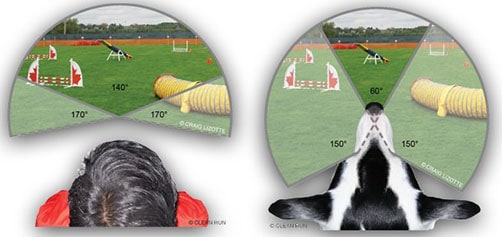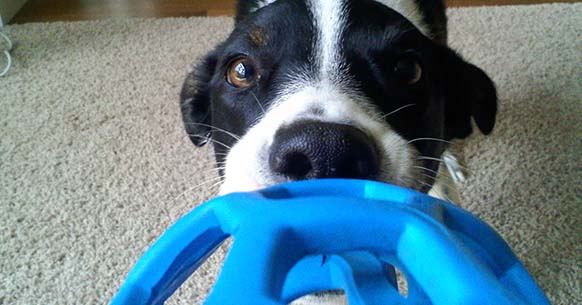How dogs see the world – A look through the eyes of a dog.
At the dog park, I throw Cole his ball and can’t understand why he passes over it so many times. It’s right under his nose! Why doesn’t he see it? I hear other owners yelling at their similarly oblivious dogs, “Get it, get it!” It’s right there. They are getting frustrated with their dog, some calling their dog stupid.
It doesn’t make sense that dogs are supposed to have such superior senses and they can’t see something right under their nose. Well, it turns out they don’t see the same as you or me. Contrary to popular belief, dogs don’t see in black and white. They see in muted shades of color. Our eyes are composed of cones and rods. The distribution of these cones and rods are different in dogs; they do not have the sharpest vision, nor do they see with quality and detail. Dogs have less cones, more rods, and tapetum tissue cell for better night vision.
Remember learning in school that “cones are for color”. Well, dogs are sort of color blind. Colors like green, orange, and red are most like shades of gray and brown. Blues, grays, browns and yellows are the primary colors dog see. “Behavior testing suggests they can distinguish red and blue colors but often confuse green and red.”

More rods allow the dog to pick up on light and movement better. This also enhances their ability to see by differentiating between shades of gray in dim light. This allows the dog to keeping their eye on a squirrel!
The tapetum tissue cell enhances the dog’s vision in dim light. These tissues can be seen by shining a bright light into the dogs eye; the eyes shine back giving them a mirrored appearance. Although the tapetum tissue cells are good for night vision it scatters reflective light detracting from visual acuity.
Visual acuity is the ability to focus on an object and judging distance. Surprisingly, dogs have poor acuity compared to humans. What a dog sees at 20 feet, we can see at 90 feet. A dog’s eyes are placed on the sides of their head, giving them better peripheral vision and a smaller focal point.

Many people buy toys without any knowledge that dogs have such severe eye sight problems. The dog toy manufacturers seem to create toys to appeal to humans. When buying a toy, consider where you are using the toy. Will your dog be playing with it on the grass, or chasing after it in the water? Blue is the better color for playing on the grass. As you can see from the picture above, blue feathers stands out better against the green palm branch. The red, yellow, and green colors are very similar appearing as muted shades of brown. In contrast to the grass, orange or yellow are better colors for toys thrown in the air.
The best thing to do is to have toys with multiple colors on them. A light and a dark contrast such as a pattern or patch or bull eyes on the toys will allow the dog to see it in either sky or grass. A plain black and white contrast would work.
Just like humans, dog’s eyes have problems, too. As your dog gets older, his eyesight changes. Dogs’ nearsighted vision declines starting at middle age, approximately 7 years old, so catching a small treat or walking down stairs might become more difficult then.
Cataracts are a common eye disease among dogs, causing clouding of the lens which can lead to blindness. There are a slew of other eye problems plaguing dogs, from simple allergic reactions to more extreme diseases, like Pannus, that can be devastating to your dog if it goes untreated.
It’s a wonder dogs can survive with such poor eye sight.
The images inside this post are used with permission from the Veterinary Vision Inc. (Source: http://veterinaryvision.com/resources/what-do-dogs-and-cats-see/)


But a sighthound’s eyes (Greyhound, Borzoi, Scottish Deerhound, etx.) are very different from a Beagle’s or a Foxhound’s.
The images are wrong. They are showing about a 190 degree field of view for the person and about a 250 degree field of view for the dog.
The faded areas of the second image represent the “blind spots.”
You might say the blind spots or the shaded areas are more peripheral vision . The dogs field of vision is more narrow than we think.
Yes sight hounds’ shape of their skull gives the dog a wider field of vision . Allowing the dog to do what they do .
Regardless of how much of a field of view the images should depict, they don’t coincide with their labels.
The first shows about a 190 degree field of view but is labeled 170 degrees.
The second shows about 250 degree field of view but is labeled 150 degrees.
I agree with you that the labeling is confusing, I’m not sure how the Veterinary Vision Inc. calculated the degrees, it looks like it’s front view plus one of the side which would equal 150 or 170 degrees. So for the left image it would be 140 + 30 = 170, and for the right image it would be 60 + 90 = 150.
This is straight from the eye vet mouth “the number of degrees in the field of view pictures refers to the field of view for EACH eye. Thus each human eye sees 170 degrees with 140 degrees of overlap (binocular vision). The OVERALL field for both eyes would then be 170+170-140 or 200 degrees. For the dog, it would be 150+150-60 or 240 degrees. Obviously, there is quite a bit of breed variation in these number for dogs, depending on how the eyes are positioned in the head.”
Hope this clears up all the controversy 🙂
You forgot to mention that dogs do a lot with their nose, so they don’t always need their eyes as much as humans do :).
The circle itself is 360. They just did not shaded the heads of human and dog. But the 170 on the left must be I think 110 and so you have again 360 degrees circle. Maybe a typing error.
The 170 labels are for each eye, humans having about 170degrees in each eye with a 140 overlap, total of about 200. The dogs having 150 with a 60 overlap, so a total of 240.
Ah… That makes total sense. Thank you Al for clarifying that for us. 🙂
The shaded areas are not blind spots, they are peripheral and so are monocular vision. The foveal area is very detailed and as the visual angle increases the resolution decreases, because of the ganglions being more concentrated nearer the fovea and mainly made up of cones. The peripherals are lacking in visual resolution because it is mainly made up of rods. The clear bits on the pictures,is binocular vision projected to V4 in the brain.
So Humans have much more binocular vision due to the setting of the eyes in the skull. Dogs have far less as the eyes are set differently.
Thank you Mj for the helpful information. 🙂
Contrary to the information given here, both of our Yorkshire terrier x dogs go mad for their red toy thrown on grass or path and tend to ignore the blue one.
The information here is way simplified version. When one sees the world, we also use lots of other visual cues such as luminance and motion. If there is a huge difference in red and green, it could stand out more than yellow and blue.
Yes . Sooyoung you are right . I wanted to keep the article very simple . I could do any article just on motion and visual cues . Colors that dogs see are very interesting, many humans don’t understand the complexity with the subtleness.